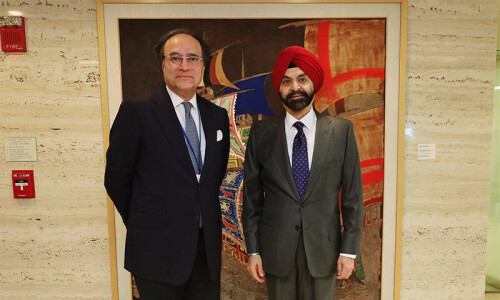In times of severe financial distress all segments of the economy and population are hurt while strenuous efforts are made to shore up the faltering financial system. The fiscal and current account deficits, and the worsening debt profile, move to the centre-stage of policy-making at the cost of social exclusion. And high inclusive growth with stability remains an elusive goal.
Owing to the trade-off, the problem of falling investment and critical trade deficit becomes unmanageable. However, it is the low level of national capital formation that is the root cause of growing dependence on foreign financial capital.
The key to economic redemption is massive domestic and foreign investment, apart from structural reforms and improved governance, says former Pakistan’s United Nations ambassador Munir Akram.
Another pertinent observation is from the book Capitalism without Capital: The Rise of the Intangible Economy’, co-authored by Jonathan Haskel and Stian Westlake. “The non- financial fixed investment is what builds capital which, together with labour, powers the economy, (its) sinews and joints, and makes the economy work,” states the book.
Low level of national capital formation is the root cause of growing dependence on foreign finances
The eminent scholars point out that “the critique that the financial system hampers the real economy, and particularly business investment, is simultaneously very old and very current… (The system’s) malign influence is getting stronger as more and more aspects of businesses are financialised”. It may be added here that the Great Depression of the early 1930s was triggered by the global financial crisis as was the recent Great Recession of 2007-08.
In Pakistan’s case, the debt-to-GDP ratio continues to rise with unprecedented borrowings and sliding growth. The International Monetary Fund’s $6 billion bailout is expected to lead to further inflows of over $38bn from other lenders over the next four years.
That includes a huge rollover of old loans of $14bn and costly commercial loans worth $8bn. Project loans account for a mere $8.7bn. However, this was followed by the Asian Development Bank’s announcement that it would extend up to $10bn ‘indicative lending’ for development projects and programmes over the next five years.
Much of these financial inflows will be spent on debt servicing. The IMF expects Islamabad to repay $37.359bn of its external debts by the end of the Fund’s programme. The country will get a net receipt of $1.65bn from the $6bn IMF package in the next four years.
The government has also agreed with the IMF to remove regulatory duties and end multiple currency practices to support balance of payments. A financial analyst says the current account deficit is to be reduced by the market-determined exchange rate without ‘suppressing a trend’ as advised by the IMF. The outcome is difficult to predict.
Simultaneously, despite austerity measures, the government’s current expenditure would shoot up to Rs7.2 trillion this year, a nearly 30 per cent jump from the revised estimate of Rs5.6tr recorded for the last fiscal year. To reduce the growing fiscal deficit, under the IMF reforms, cumulative tax revenues are stipulated to increase by Rs10.5tr over the next five years.
Such a massive effort to raise tax revenues will tend to starve the market of the liquidity in a sluggish economy and stifle investment. However, fiscal experts say the Fund seems to be too optimistic in its estimates. In this scenario the level of public sector development spending and private investment will remain under clouds while the development deficit is likely to mount.
From the viewpoint of investors, the economic outlook is bleak. A 2500- strong representative gathering of commerce and trade bodies of Punjab, by far the largest provincial economy, has described the current economic situation ‘as the worst ever in the country’s history.’
The credit off-take by the private sector dipped by 1.7pc to Rs607.3bn as of June 21 FY2019 when compared to Rs618bn during the same period of the preceding year despite rise in working capital loans on account of an increase in the cost of industrial inputs. This indicates lower capacity utilisation.
Speaking at the Tajir Bachao conference held in Lahore on July 5, Pakistan’s Traders Alliance Lahore’s chief Nasir Hameed, said ‘we reject this (2019-20) budget made by the bureaucrats and the IMF’. His words give credence to an eminent economist who once said, “fixed investment tends to rise and fall dramatically in response to monetary and fiscal policies and business confidence.”
To pacify the trading community, Federal Board of Revenue chief Shabbar Zaidi was sent later by the government to address the Lahore Chamber of Commerce and Industry and clarify the various tax issues agitating the business community. Mr Zaidi told his audience that the main theme of the federal budget 2019-20 was ‘development of the industrial sector and to generate employment opportunities’.
Disagreeing with the FBR chief, the acting president of the Lahore Chamber, Faheem-ur-Rehman Saigol argued that “certain measures taken in the budget would prove to be counterproductive for the industrial sector which contributes 70pc to the tax revenues”. He suggested changes in the taxes levied.
While the viability of greenfield projects remains in a flux owing to rising tax-related costs and hassles of doing business, the government is struggling with the privatisation policy for the last ten months. For the first time, to quote the prime minister’s advisor on finance Dr Abdul Hafeez Shaikh, the financial team would consider closing down state-run units that required liquidation. The IMF wants Pakistan to privatise at least seven small state-run entities in the short-term.
The CPEC phase of industrialisation is still in the planning stages while the domestic industry has yet to be prepared for producing innovative products that can find ready export markets. ADB Country Director for Pakistan Ziaohong Yang says his bank’s proposed lending “will prioritise innovation, analytical support, public-private partnership and the application of new technologies”.
Published in Dawn, The Business and Finance Weekly, July 15th, 2019















































